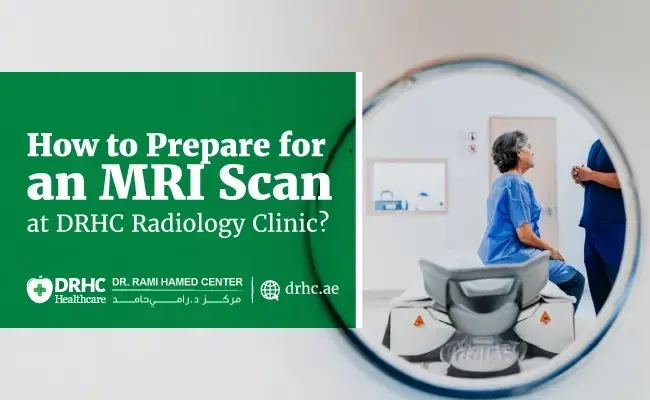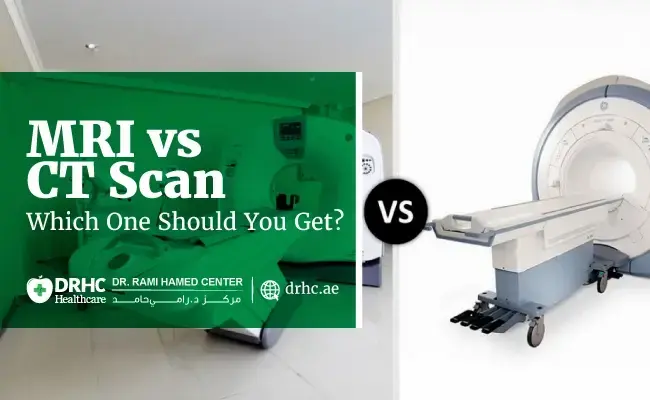
When it comes to breast health, early detection can be lifesaving. But with different screening and diagnostic tools available — especially mammograms and breast MRIs — many patients feel unsure about which test is best for their situation.
At Dr. Rami Hamed Center (DRHC) in Dubai, we understand that facing a breast health concern or even just going for a routine screening can bring anxiety and uncertainty. This blog is designed to help you better understand the differences between mammograms and breast MRIs, when each is used, and how to decide which option may be right for you.
What Is a Mammogram?
A mammogram is an X-ray image of the breast that helps detect lumps, calcifications, or other signs of breast cancer, often before symptoms appear. It is the most widely recommended screening tool for breast cancer and is typically advised annually or every two years for women over 40.
- How it works: During a mammogram, each breast is gently compressed between two plates to get clear X-ray images from different angles.
- Time required: About 15–20 minutes.
- Radiation exposure: Very low dose, considered safe.
- Best for: Routine screening in women at average risk of breast cancer.
What Is a Breast MRI?
A breast MRI (Magnetic Resonance Imaging) uses magnetic fields and radio waves — not X-rays — to create highly detailed images of the breast. It is more sensitive than a mammogram and can detect small abnormalities that may not appear on an X-ray.
- How it works: You lie face down inside the MRI machine while contrast dye is injected through a vein to highlight breast tissues.
- Time required: About 30–60 minutes.
- Radiation exposure: None.
- Best for: Women at high risk for breast cancer or for further evaluation when a mammogram or ultrasound shows unclear results.
Breast MRI vs. Mammogram – Key Differences
| Feature | Mammogram | Breast MRI |
|---|---|---|
| Radiation | Yes (low dose) | No |
| Image Detail | Good | Excellent (especially for dense breasts) |
| Used For | Routine screening | High-risk screening or follow-up |
| Contrast Dye Needed | No | Yes |
| Time Required | Shorter | Longer |
| Availability at DRHC Dubai | ✔️ | ✔️ |
When Is a Breast MRI Recommended?
While mammograms remain the first choice for most women, breast MRI may be recommended if you:
- Have a strong family history of breast cancer (e.g., BRCA1/BRCA2 mutations)
- Had radiation to the chest at a young age
- Have dense breast tissue, which can make mammograms less accurate
- Are being monitored for breast cancer recurrence, or are on surveillance after treatment
- Need further investigation after an inconclusive mammogram or ultrasound
At DRHC Dubai, our specialists carefully evaluate your risk factors before recommending breast MRI, ensuring that the test is appropriate and valuable for your health.
Screening Guidelines at a Glance
- Women aged 40–74: Annual or biennial mammogram screening is generally recommended.
- High-risk women (BRCA mutation, family history, etc.): May need annual breast MRI in addition to mammograms, starting at an earlier age.
- Women with symptoms (e.g., a lump or nipple discharge): Diagnostic imaging, including mammogram, ultrasound, or MRI as needed.
Our breast imaging specialists at DRHC Dubai follow evidence-based screening guidelines and tailor them to your personal health history.
Explore Our Related Blogs
- MRV Brain Scan Explained: Symptoms That Shouldn’t Be Ignored
- Signs You Might Have a Brain Aneurysm – And Why MRA Can Help
- Can Brain MRI Detect Early Alzheimer’s or Dementia?
- Why Prostate MRI is a Game-Changer for Cancer Detection
Common Patient Concerns: Addressed with Care
Is a mammogram painful?
Some women feel mild discomfort or pressure during breast compression, but it lasts only a few seconds. Our radiology team takes care to make the experience as comfortable as possible.
Is MRI safe for everyone?
Breast MRI is very safe, but it may not be suitable if you have certain metal implants or severe claustrophobia. The contrast dye used is generally well tolerated, but those with kidney issues should discuss this with their doctor.
Do I need both tests?
In some cases, yes. For high-risk individuals, both mammogram and MRI may be recommended because they complement each other — MRI is more sensitive, while mammograms can detect certain calcifications better.
What if I have dense breasts?
Dense breast tissue is common and can make cancers harder to detect on a mammogram. A supplemental MRI or ultrasound may be advised based on your individual case.
Conclusion: The Right Test for the Right Person
There is no one-size-fits-all approach when it comes to breast imaging. Mammograms are the gold standard for routine screening, while breast MRIs serve as a valuable tool for those at higher risk or in need of more detailed assessment.
At Dr. Rami Hamed Center (DRHC) in Dubai, we are committed to helping you make informed choices about your breast health. Our radiology and women’s health teams provide personalized care, advanced imaging technology, and compassionate guidance — every step of the way.
Need a breast imaging consultation in Dubai?
Our experts at DRHC Dubai are here to help you choose the right screening plan for your needs. Whether you’re coming in for your first mammogram or seeking a second opinion, we’re ready to support you with clarity and care.
📞 +971 4 279 8800
🌐 www.drhc.ae
📍 Dubai Healthcare City, Building 52









Leave a comment